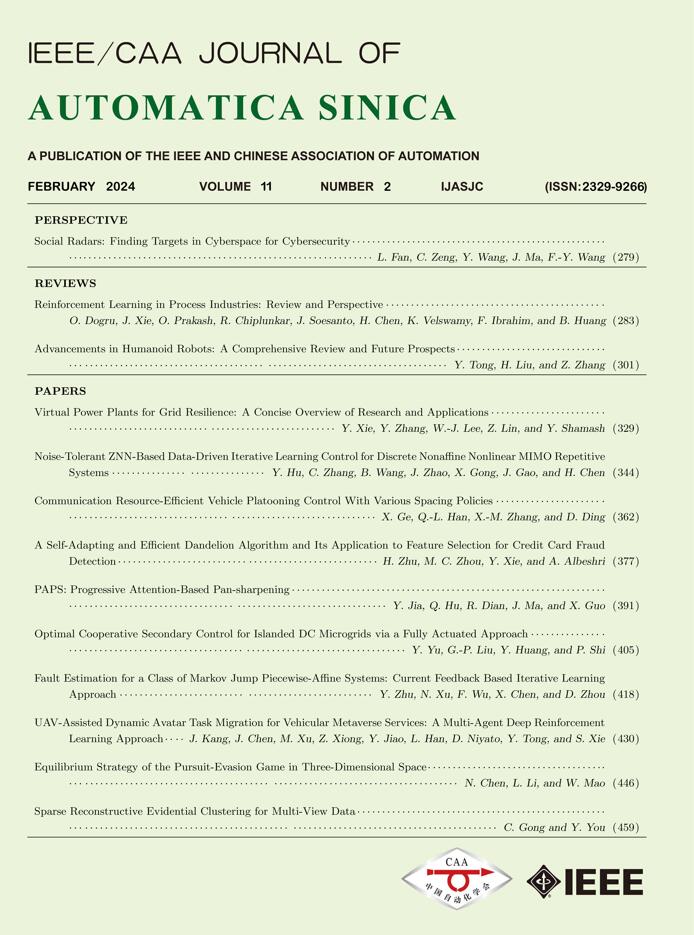 Volume 11
Issue 2
Volume 11
Issue 2
IEEE/CAA Journal of Automatica Sinica
| Citation: | F. Ming, W. Gong, and Y. Jin, “Even search in a promising region for constrained multi-objective optimization,” IEEE/CAA J. Autom. Sinica, vol. 11, no. 2, pp. 474–486, Feb. 2024. doi: 10.1109/JAS.2023.123792 |
In recent years, a large number of approaches to constrained multi-objective optimization problems (CMOPs) have been proposed, focusing on developing tweaked strategies and techniques for handling constraints. However, an overly fine-tuned strategy or technique might overfit some problem types, resulting in a lack of versatility. In this article, we propose a generic search strategy that performs an even search in a promising region. The promising region, determined by obtained feasible non-dominated solutions, possesses two general properties. First, the constrained Pareto front (CPF) is included in the promising region. Second, as the number of feasible solutions increases or the convergence performance (i.e., approximation to the CPF) of these solutions improves, the promising region shrinks. Then we develop a new strategy named even search, which utilizes the non-dominated solutions to accelerate convergence and escape from local optima, and the feasible solutions under a constraint relaxation condition to exploit and detect feasible regions. Finally, a diversity measure is adopted to make sure that the individuals in the population evenly cover the valuable areas in the promising region. Experimental results on 45 instances from four benchmark test suites and 14 real-world CMOPs have demonstrated that searching evenly in the promising region can achieve competitive performance and excellent versatility compared to 11 most state-of-the-art methods tailored for CMOPs.

| [1] |
Z. Ma and Y. Wang, “Shift-based penalty for evolutionary constrained multiobjective optimization and its application,” IEEE Trans. Cyber., vol. 53, no. 1, pp. 18–30, Jan. 2023. doi: 10.1109/TCYB.2021.3069814
|
| [2] |
Y. Hua, Q. Liu, K. Hao, and Y. Jin, “A survey of evolutionary algorithms for multi-objective optimization problems with irregular Pareto fronts,” IEEE/CAA J. Autom. Sinica, vol. 8, no. 2, pp. 303–318, 2021.
|
| [3] |
Z. Liu and Y. Wang, “Handling constrained multiobjective optimization problems with constraints in both the decision and objective spaces,” IEEE Trans. Evolutionary Computation, vol. 23, no. 5, pp. 870–884, 2019.
|
| [4] |
K. Li, R. Chen, G. Fu, and X. Yao, “Two-archive evolutionary algorithm for constrained multiobjective optimization,” IEEE Trans. Evolutionary Computation, vol. 23, no. 2, pp. 303–315, 2019. doi: 10.1109/TEVC.2018.2855411
|
| [5] |
Y. Tian, Y. Zhang, Y. Su, X. Zhang, K. C. Tan, and Y. Jin, “Balancing objective optimization and constraint satisfaction in constrained evolutionary multiobjective optimization,” IEEE Trans. Cyber., vol. 52, no. 9, pp. 9559–9572, Sept. 2022. doi: 10.1109/TCYB.2020.3021138
|
| [6] |
J. Liang, K. Qiao, K. Yu, B. Qu, C. Yue, W. Guo, and L. Wang, “Utilizing the relationship between unconstrained and constrained Pareto fronts for constrained multiobjective optimization,” IEEE Trans. Cyber., vol. 53, no. 6, pp. 3873–3886, Jun. 2023. doi: 10.1109/TCYB.2022.3163759
|
| [7] |
Z. Fan, W. Li, X. Cai, H. Li, C. Wei, Q. Zhang, K. Deb, and E. Goodman, “Push and pull search for solving constrained multi-objective optimization problems,” Swarm and Evolutionary Computation,, vol. 44, pp. 665–679, 2019. doi: 10.1016/j.swevo.2018.08.017
|
| [8] |
Z. Sun, H. Ren, G. G. Yen, T. Chen, J. Wu, H. An, and J. Yang, “An evolutionary algorithm with constraint relaxation strategy for highly constrained multiobjective optimization,” IEEE Trans. Cyber., vol. 53, no. 5, pp. 3190–3204, May 2023. doi: 10.1109/TCYB.2022.3151974
|
| [9] |
J. Yuan, H.-L. Liu, and Z. He, “A constrained multi-objective evolutionary algorithm using valuable infeasible solutions,” Swarm and Evolutionary Computation, vol. 68, p. 101020, 2022.
|
| [10] |
F. Ming, W. Gong, L. Wang, and C. Lu, “A tri-population based coevolutionary framework for constrained multi-objective optimization problems,” Swarm and Evolutionary Computation, vol. 70, p. 101055, 2022.
|
| [11] |
D. Wolpert and W. Macready, “No free lunch theorems for optimization,” IEEE Trans. Evolutionary Computation, vol. 1, no. 1, pp. 67–82, 1997. doi: 10.1109/4235.585893
|
| [12] |
Y. Tian, T. Zhang, J. Xiao, X. Zhang, and Y. Jin, “A coevolutionary framework for constrained multiobjective optimization problems,” IEEE Trans. Evolutionary Computation, vol. 25, no. 1, pp. 102–116, 2021.
|
| [13] |
R. Jiao, B. Xue, and M. Zhang, “A multiform optimization framework for constrained multiobjective optimization,” IEEE Trans. Cyber., vol. 53, no. 8, pp. 5165–5177, Aug. 2023. doi: 10.1109/TCYB.2022.3178132
|
| [14] |
K. Yu, J. Liang, B. Qu, Y. Luo, and C. Yue, “Dynamic selection preference-assisted constrained multiobjective differential evolution,” IEEE Trans. Systems,Man,and Cyber.: Systems, vol. 52, no. 5, pp. 2954–2965, 2022.
|
| [15] |
Z. Ma, Y. Wang, and W. Song, “A new fitness function with two rankings for evolutionary constrained multiobjective optimization,” IEEE Trans. Systems,Man,and Cyber.: Systems, vol. 51, no. 8, pp. 5005–5016, 2021.
|
| [16] |
J. Zhou, J. Zou, J. Zheng, S. Yang, D. Gong, and T. Pei, “An infeasible solutions diversity maintenance epsilon constraint handling method for evolutionary constrained multiobjective optimization,” Soft Computing, vol. 25, no. 13, pp. 8051–8062, 2021.
|
| [17] |
C. Qin, F. Ming, W. Gong, and Q. Gu, “Constrained multi-objective optimization via two archives assisted push-pull evolutionary algorithm,” Swarm and Evolutionary Computation, vol. 75, p. 101178, 2022. doi: 10.1016/j.swevo.2022.101178
|
| [18] |
Y. Tian, R. Cheng, X. Zhang, and Y. Jin, “PlatEMO: A MATLAB platform for evolutionary multi-objective optimization,” IEEE Computational Intelligence Magazine, vol. 12, pp. 73–87, 2017.
|
| [19] |
Z. Ma and Y. Wang, “Evolutionary constrained multiobjective optimization: Test suite construction and performance comparisons,” IEEE Trans. Evolutionary Computation, vol. 23, no. 6, pp. 972–986, 2019.
|
| [20] |
Z. Fan, W. Li, X. Cai, H. Huang, Y. Fang, Y. Yugen, J. Mo, C. Wei, and E. Goodman, “An improved epsilon constraint-handling method in MOEA/D for CMOPS with large infeasible regions,” Soft Computing, vol. 23, pp. 12491–12510, 2019.
|
| [21] |
Z. Fan, W. Li, X. Cai, H. Li, C. Wei, Q. Zhang, K. Deb, and E. Goodman, “Difficulty adjustable and scalable constrained multiobjective test problem toolkit,” Evolutionary Computation, vol. 28, no. 3, pp. 339–378, 2020.
|
| [22] |
A. Kumar, G. Wu, M. Z. Ali, Q. Luo, R. Mallipeddi, P. N. Suganthan, and S. Das, “A benchmark-suite of real-world constrained multiobjective optimization problems and some baseline results,” Swarm and Evolutionary Computation, vol. 67, p. 100961, 2021.
|
| [23] |
Z.-Z. Liu, B.-C. Wang, and K. Tang, “Handling constrained multiobjective optimization problems via bidirectional coevolution,” IEEE Trans. Cyber., vol. 52, no. 10, pp. 10163–10176, Oct. 2022. doi: 10.1109/TCYB.2021.3056176
|
| [24] |
H. Ishibuchi, R. Imada, N. Masuyama, and Y. Nojima, “Comparison of hypervolume, IGD and IGD+ from the viewpoint of optimal distributions of solutions,” in Proc. Evolutionary Multi-Criterion Optimization, 2019, pp. 332–345.
|
| [25] |
E. Zitzler and L. Thiele, “Multiobjective evolutionary algorithms: A comparative case study and the strength pareto approach,” IEEE Trans. Evolutionary Computation, vol. 3, no. 4, pp. 257–271, 1999.
|
| [26] |
H. Ishibuchi, L. M. Pang, and K. Shang, “Difficulties in fair performance comparison of multi-objective evolutionary algorithms [research frontier],” IEEE Computational Intelligence Magazine, vol. 17, no. 1, pp. 86–101, 2022.
|
| [27] |
Z. Lv, L. Wang, Z. Han, and J. Zhao, “Surrogate-assisted particle swarm optimization algorithm with Pareto active learning for expensive multiobjective optimization,” IEEE/CAA J. Autom. Sinica, vol. 6, no. 3, pp. 838–849, 2019.
|
| [28] |
Y. Tian, L. Si, X. Zhang, K. C. Tan, and Y. Jin, “Local modelbased Pareto front estimation for multiobjective optimization,” IEEE Trans. Systems,Man,and Cyber.: Systems, vol. 53, no. 1, pp. 623–634, Jan. 2023. doi: 10.1109/TSMC.2022.3186546
|
| [29] |
Y. Tian, H. Chen, H. Ma, X. Zhang, K. Tan, and Y. Jin, “Integrating conjugate gradients into evolutionary algorithms for large-scale continuous multi-objective optimization,” IEEE/CAA J. Autom. Sinica, vol. 9, no. 10, p. 1801–1817, 2022.
|
| [30] |
W. Li, X. Yao, K. Li, R. Wang, and T. Zhang, “Coevolutionary framework for generalized multimodal multi-objective optimization,” IEEE/CAA J. Autom. Sinica, vol. 10, no. 7, pp. 1544–1556, 2022.
|
| [31] |
Y. Tian, Y. Feng, X. Zhang, and C. Sun, “A fast clustering based evolutionary algorithm for super-large-scale sparse multi-objective optimization,” IEEE/CAA J. Autom. Sinica, vol. 10, no. 4, pp. 1048–1063, 2023. doi: 10.1109/JAS.2022.105437
|
 JAS-2023-0595-supp.pdf
JAS-2023-0595-supp.pdf
|

|